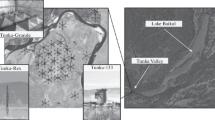Abstract
Andes Large-area PArticle detector for Cosmic-ray physics and Astronomy (ALPACA) is an international experiment that applies southern very-high-energy (VHE) gamma-ray astronomy to determine the origin of cosmic rays around the knee energy region (1015eV − 1016eV). The experiment consists of an air shower (AS) array with a surface of 83,000m2 and an underground water Cherenkov muon detector (MD) array covering 5,400m2. The experimental site is at the Mt. Chacaltaya plateau in La Paz, Bolivia, with an altitude of 4,740m corresponding to 572g/cm2 atmospheric thickness. As the prototype experiment of ALPACA, the ALPAQUITA experiment aims to begin data acquisition in late 2021. The ALPAQUITA array consists of a smaller AS array (18,450m2) and underground MD (900m2), which are now under construction. ALPAQUITA’s sensitivity to gamma-ray sources is evaluated with Monte Carlo simulations. The simulation finds that five gamma-ray sources observed by H.E.S.S. and HAWC experiments will be detected by ALPAQUITA beyond 10TeV and ne out of these five - HESS J1702-420A - above 300 TeV in one calendar year observation. The latter finding means that scientific discussions can be made on the emission mechanism of gamma rays beyond 100TeV from southern sources on the basis of the observational results of this prototype experiment.


















Similar content being viewed by others
References
Hess, V.F.: Über Neuerungen und Erfahrungen an den Radiummessungen nach der Gamma-Strahlenmethode. Phys. Z. 14, 1135 (1913)
Kulikov, G.V., Kristiansen, G.B., Eksp, Z.H.: On the size spectrum of extensive air showers. Teor. Fis. 35, 635 (1958)
Bird, D.J., et al.: Evidence for correlated changes in the spectrum and composition of cosmic rays at extremely high energies. Phys. Rev. Lett. 71, 3401 (1993)
Bell, A.R.: Cosmic ray acceleration. Astropart. Phys. 43, 56 (2013)
Baade, W., Zwicky, F.: Cosmic rays from super-novae. Astronomy 20, 259 (1934)
Fermi, E.: On the origin of the cosmic radiation. Phys. Rev. Lett. 75, 1169 (1949)
Bykov, A.M., Ellison, D.C., Marcowith, A., et al: Cosmic ray production in supernovae. Space Sci. Rev. 41, 214 (2018)
Amato, E., Blasi, P.: A general solution to non-linear particle acceleration at non-relativistic shock waves. Mon. Not. R. Astron. Soc. 364, 76 (2005)
Amato, E., Blasi, P.: Non-linear particle acceleration at non-relativistic shock waves in the presence of self-generated turbulence. Mon. Not. R. Astron. Soc. 371, 1251 (2006)
Dermer, C.D.: Secondary production of neutral pi-mesons and the diffuse galactic gamma radiation. Astron. Astrophys. 157, 223 (1986)
Naito, T., Takahara, F.: High energy gamma-ray emission from supernova remnants. J. Phys. G: Nucl. Part. Phys. 20, 477 (1994)
Ackermann, M., et al.: Detection of the characteristic pion-decay signature in supernova remnants. Science 339, 807 (2013)
Kelner, S.R., Aharonian, F., Bugayov, V.V.: Energy spectra of gamma rays, electrons, and neutrinos produced at proton-proton interactions in the very high energy regime. Phys. Rev. D 74, 034018 (2006)
Amenomori, M., et al.: First detection of photons with energy beyond 100 TeV from an astrophysical source. Phys. Rev. Lett. 123, 051101 (2019)
Abeysekara, A.U., et al.: Measurement of the Crab Nebula spectrum past 100 TeV with HAWC. Astrophys. J. 881, 134 (2019)
Aharonian, F., et al.: Observation of the Crab Nebula with LHAASO-KM2A - a performance study. Chin. Phys. C 45, 025002 (2021)
Abeysekara, A.U., et al.: Multiple Galactic sources with emission above 56 TeV detected by HAWC. Phys. Rev. Lett. 124, 021102 (2020)
Cao, Z., Aharonian, F., An, Q., et al: Observation of the Crab Nebula with LHAASO-KM2A - a performance study. Nature 594, 33 (2021)
Albert, A., et al.: HAWC J2227 + 610 and its association with G106.3 + 2.7, a new potential Galactic PeVatron. Astrophys. J. 896(2), L29 (2020)
Amenomori, M., et al.: Potential PeVatron supernova remnant G106.3 + 2.7 seen in the highest-energy gamma rays. Nat. Astron. 5, 460 (2021)
Abeysekara, A.U., et al.: HAWC observations of the acceleration of very-high-energy cosmic rays in the Cygnus Cocoon. Nat. Astron. 5, 465 (2021)
Amenomori, M., et al.: Gamma-ray observation of the Cygnus region in the 100-TeV energy region. Phys. Rev. Lett. 127, 031102 (2021)
Amenomori, M., et al.: First detection of sub-PeV diffuse gamma rays from the Galactic disk: Evidence for ubiquitous galactic cosmic rays beyond PeV energies. Phys. Rev. Lett. 126, 141101 (2021)
Abramowski, A., et al.: Acceleration of petaelectronvolt protons in the Galactic Centre. Nature 531, 476 (2016)
Abdalla, H., et al.: Characterising the VHE diffuse emission in the central 200 parsecs of our Galaxy with H.E.S.S. Astron. Astrophys. 612, A9 (2018)
Abramowski, A., et al.: The H.E.S.S. Galactic plane survey. Astron. Astrophys. A1, 612 (2018)
Lipari, P., Vernetto, S.: Diffuse Galactic gamma-ray flux at very high energy. Phys. Rev. D 98, 043003 (2020)
Amenomori, M., et al.: Are protons still dominant at the knee of the cosmic-ray energy spectrum? Phys. Lett. B 632, 58 (2006)
Amenomori, M., et al.: Northern sky galactic cosmic ray anisotropy between 10 and 1000 TeV with the Tibet air shower array. Astrophys. J. 836, 153 (2017)
Amenomori, M., et al.: Probe of the solar magnetic field using the “cosmic-ray shadow” of the Sun. Phys. Rev. Lett. 111, 011101 (2013)
Amenomori, M., et al.: Evaluation of the interplanetary magnetic field strength using the cosmic-ray shadow of the Sun. Phys. Rev. Lett. 120, 031101 (2018)
Heck, D., Knapp, J., Capdevielle, J.N., Schats, G., Thouw, T.: CORSIKA: A Monte Carlo code to simulate extensive air showers. Report FZKA, pp. 6019 (1998)
Muraishi, H., et al.: Evidence for TeV gamma-ray emission from the shell type SNR RX J1713.7-3946. Astron. Astrophys. 354, 57 (2000)
Abdo, A.A., et al.: Observations of the young supernova remnant RX J1713.7-3946 with the Fermi Large Area Telescope. Astrophys. J. 734, 28 (2011)
Abdalla, H., et al.: H.E.S.S. observations of RX J1713.7-3946 with improved angular and spectral resolution: Evidence for gamma-ray emission extending beyond the X-ray emitting shell. Astron. Astrophys. 612, A6 (2018)
Shibata, M., Katayose, Y., Huang, J., Chen, D.: Chemical composition and maximum energy of Galactic cosmic rays. Astrophys. J. 716, 1076 (2010)
Battistoni, G., et al.: Overview of the FLUKA code. Ann. Nucl. Energy 82, 10 (2015)
Pierog, T., Karpenko, I., Katzy, J.M., Yatsenko, E., Werner, K.: EPOS LHC: Test of collective hadronization with data measured at the CERN Large Hadron Collider. Phys. Rev. C 92, 034906 (2015)
Agostinelli, S., et al.: GEANT4-a simulation toolkit. Nucl. Instrum. Methods Phys. Res. A 506, 250 (2003)
Sako, T.K., et al.: Exploration of a 100 TeV gamma-ray northern sky using the Tibet air-shower array combined with an underground water-Cherenkov muon-detector array. Astropart. Phys. 32, 177 (2009)
Aharonian, F., et al.: The Crab Nebula and pulsar between 500 GeV and 80 TeV: Observations with the HEGRA stereoscopic air cherenkov telescopes. Astrophys. J. 614, 897 (2004)
Abdalla, H., et al.: The supernova remnant W49B as seen with H.E.S.S. and Fermi-LAT. Astron. Astrophys. A5, 612 (2018)
Abramowski, A., et al.: H.E.S.S. detection of TeV emission from the interaction region between the supernova remnant G349.7 + 0.2 and a molecular cloud. Astron. Astrophys. A100, 574 (2015)
Abramowski, A., et al.: A new SNR with TeV shell-type morphology: HESS J1731-347. Astron. Astrophys. A81, 531 (2011)
Aharonian, F., et al.: Very high energy gamma rays from the composite SNR G 0.9 + 0.1. Astron. Astrophys. 432, 25 (2011)
Abdalla, H., et al.: Evidence of 100 TeV gamma-ray emission from HESS J1702-420: A new PeVatron candidate. arXiv:2106.06405v2(2021)
Vernetto, S., Lipari, P.: Absorption of very high energy gamma rays in the Milky Way. Phys. Rev. D 94, 063009 (2016)
Lau, J.C., et al.: Probing the origin of the unidentified TeV gamma-ray source HESS J1702-420 via the surrounding interstellar medium. Mon. Not. R. Astron. Soc. 483, 3659 (2019)
Aharonian, F., et al.: HESS very-high-energy gamma-ray sources without identified counterparts. Astron. Astrophys. 477, 353 (2008)
Chang, C., et al.: Search for pulsar wind nebula associations with unidentified TeV gamma-ray sources. Astrophys. J. 682, 1177 (2008)
Fujinaga, T., et al.: Suzaku observation of the unidentified very high energy gamma-ray source HESS J1702-420. Astrophys. Soc. Jpn. 63, S857 (2011)
Eagle, J., et al.: Gamma-ray emission revealed at the western edge of SNR G344.7-0.1. Astrophys. J. 904, 123 (2020)
Giacani, E.B., Smith, M.J.S., Dubner, G., Loiseau, N.: A new study of the supernova remnant G344.7-0.1 located in the vicinity of the unidentified TeV source HESS J1702-420. Astron. Astrophy. A138, 531 (2011)
Kawata, K., Sako, T.K., Ohnishi, M., et al: Energy determination of gamma-ray induced air showers observed by an extensive air shower array. Exp. Astron. 44, 1 (2017)
Acknowledgements
The ALPACA project is supported by the Japan Society for the Promotion of Science (JSPS) through Grants-in-Aid for Scientific Research (A) 19H00678, Scientific Research (B) 19H01922, and Scientific Research (S) 20H05640, the LeoAtrox supercomputer located at the facilities of the Centro de Análisis de Datos (CADS), CGSAIT, Universidad de Guadalajara, México, and by the joint research program of the Institute for Cosmic Ray Research (ICRR), The University of Tokyo. K. Kawata is supported by the Toray Science Foundation. E. de la Fuente thanks Coordinación General Académica y de Innovación (CGAI-UDG), cuerpo académico PRODEP-UDG-CA-499, Carlos Iván Moreno, Cynthia Ruano, Rosario Cedano, and Diana Naylleli, for financial and administrative support during sabbatical year stay at the ICRR on 2021. I. Toledano-Juarez acknowledges support from CONACyT, México; grant 754851. F. Orozco-Luna thanks CONACyT Ph. D. Grant 2021-000001-01NACF-02328.
Author information
Authors and Affiliations
Corresponding author
Additional information
Publisher’s note
Springer Nature remains neutral with regard to jurisdictional claims in published maps and institutional affiliations.
Rights and permissions
About this article
Cite this article
Kato, S., Condori, C.A.H., Fuente, E.d.l. et al. Detectability of southern gamma-ray sources beyond 100 TeV with ALPAQUITA, the prototype experiment of ALPACA. Exp Astron 52, 85–107 (2021). https://doi.org/10.1007/s10686-021-09796-8
Received:
Accepted:
Published:
Issue Date:
DOI: https://doi.org/10.1007/s10686-021-09796-8




